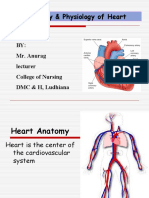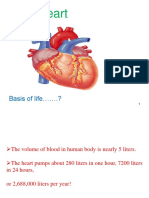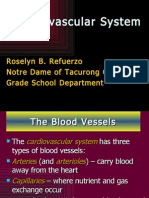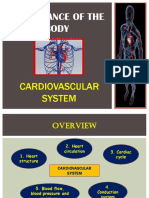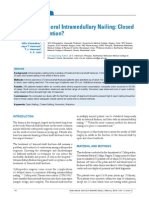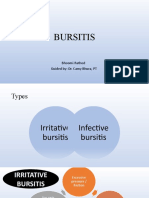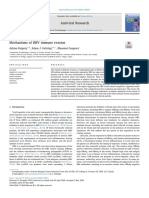Circulatory System
Circulatory System
Uploaded by
Trisha Mae BolotaoloCopyright:
Available Formats
Circulatory System
Circulatory System
Uploaded by
Trisha Mae BolotaoloOriginal Description:
Copyright
Available Formats
Share this document
Did you find this document useful?
Is this content inappropriate?
Copyright:
Available Formats
Circulatory System
Circulatory System
Uploaded by
Trisha Mae BolotaoloCopyright:
Available Formats
Circulation and Respiration
Chapter 21
21.1 Impacts/Issues
Up in Smoke
Smoking, a habit that usually begins in the
teens, impairs the health of smokers and the
people around them
Video: Up in smoke
21.2 Moving Substances Through a Body
All animals must supply their cells with nutrients
and oxygen, and remove wastes
In some small invertebrates, materials simply
diffuse through interstitial fluid
Interstitial fluid
Fluid between cells of a multicelled body
Circulatory Systems
Complex animals distribute materials through a
circulatory system, in which a heart pumps blood
through blood vessels
Heart
Muscular organ that pumps fluid through a body
Open circulatory system
Circulatory system in which blood leaves vessels
and flows among tissues
aorta heart
Two Types of Circulatory Systems
In a grasshoppers open system, the hearts pump blood
through a vessel (an aorta). From there, blood moves into
tissue spaces, mingles with fluid bathing cells, then reenters
the hearts through openings in the heart wall.
Two Types of Circulatory Systems
Closed circulatory system
Circulatory system in which blood stays inside a
continuous network of vessels
Flow is faster than in open systems
Found in all vertebrates and some invertebrates
(C, D) Blood in the closed system of an earthworm stays
inside pairs of muscular hearts near the head and many
blood vessels.
Closed Circulatory System
In a closed circulatory system, materials are
transferred between blood and cells of other
tissues by diffusion through capillaries
Capillaries
Smallest-diameter blood vessels; site of
exchanges of gases and other materials with
tissues; a capillary bed supplies an organ
Open and Closed Circulatory Systems
Fig. 21-1c, p. 419
Fig. 21-1c, p. 419
dorsal blood vessel
two of five
hearts
ventral blood
vessels
gut cavity
Fig. 21-1d, p. 419
Fig. 21-1d, p. 419
pump
large-diameter
blood vessels
(rapid flow)
large-diameter
blood vessels
(rapid flow)
capillary bed (many small vessels
that serve as a diffusion zone)
Animation: Types of circulatory systems
Evolution of
Vertebrate Cardiovascular Systems
Fishes have a two-chambered heart
(atrium and ventricle), and blood
flows in one circuit
Atrium
Heart chamber that receives
blood from a vein and pumps it
into a ventricle
Ventricle
Heart chamber that pumps blood
out of the heart and into an artery
Evolution of
Vertebrate Cardiovascular Systems
In most vertebrates,
blood flows in two
circuits
Amphibians and most
reptiles have a three-
chambered heart with
two atria and one
ventricle
Evolution of
Vertebrate Cardiovascular Systems
Crocodilians, birds,
and mammals have
a four-chambered
heart that separates
oxygen-rich blood
from oxygen-poor
blood
Two Cardiovascular Circuits
Pulmonary circuit
Circuit through which
blood flows from the
heart to the lungs and
back
Systemic circuit
Circuit through which
blood flows from the
heart to the body
tissues and back
Vertebrate Circulatory Systems
Fig. 21-2a, p. 420
capillary beds
of gills
ventricle
heart
rest of body
atrium
Fig. 21-2b, p. 420
Fig. 21-2b, p. 420
lungs
right
atrium
left
atrium
ventricle
rest of body
Fig. 21-2c, p. 420
Fig. 21-2c, p. 420
lungs
right
atrium
left
atrium
right ventricle left ventricle
rest of body
Animation: Circulatory systems
21.3 Human Cardiovascular System
The human heart has four
chambers, and pumps
blood through two
separate circuits:
pulmonary and systemic
Each circuit has a
network of blood vessels
that carry blood between
the heart and capillary
beds
Types of Blood Vessels
Artery
Large-diameter blood
vessel that carries
blood from the heart to
an organ
Arteriole
Blood vessel that
carries blood from an
artery to a capillary bed
Types of Blood Vessels
Venule
Small-diameter blood
vessel that carries
blood from capillaries
to a vein
Vein
Large-diameter
vessel that returns
blood to the heart
The Pulmonary Circuit
Oxygen-poor blood collected
by the right atrium is pumped
from the right ventricle,
through pulmonary arteries,
to the lungs
In the lungs, blood gives off
CO
2
and picks up O
2
Oxygen-rich blood returns
through pulmonary veins to
the left atrium
The Systemic Circuit
Oxygen-rich blood
collected by the left
atrium is pumped from
the left ventricle, through
the aorta, to capillary
beds of the body
Aorta
Large artery that
receives blood pumped
out of the left ventricle
The Systemic Circuit
At capillary beds in the body, blood gives up O
2
and picks up CO
2
Most blood flows through only one capillary bed,
but blood from gut capillaries also passes through
liver capillaries before retuning to the heart
Oxygen-poor blood returns to the right atrium
The Human Cardiovascular System
Fig. 21-3a, p. 421
Heart
atrium ventricle
veins arteries
venules arterioles
capillaries
Blood flow in the human cardiovascular
system
In the pulmonary circuit, blood flows from the hearts right ventricle into pulmonary arteries
that carry it to the lungs. As it flows through pulmonary capillaries, it picks up oxygen.
Pulmonary veins deliver the blood to the hearts left atrium. (C) In the systemic circuit, blood
flows from the hearts left ventricle into the aorta, the bodys largest artery. Branches of the
aorta carry the blood to arterioles, then to capillaries in various organs. Blood from these
capillary beds collects in venules that feed into veins. The veins return the blood to the heart.
They empty into the right atrium.
Fig. 21-3b, p. 421
right pulmonary artery left pulmonary artery
capillary bed
of right lung
capillary bed
of left lung
pulmonary
trunk
to systemic
circuit
from
systemic
circuit
pulmonary
veins
heart
Fig. 21-3c, p. 421
Fig. 21-3c, p. 421
capillary beds of head,
upper extremities
to pulmonary
circuit
aorta
from
pulmonary
circuit
heart
capillary beds of other
organs in thoracic cavity
capillary bed of liver
capillary beds of intestines
capillary beds of other abdominal
organs and lower extremities
Animation: Human blood circulation
Human blood circulation
21.4 The Human Heart
Structures of the human heart
Pericardium protects the heart
Each half of the heart has two chambers: an
upper atrium and a lower ventricle
Superior and inferior vena cava deliver blood to
the right atrium
Pulmonary veins deliver blood to the left atrium
Atrioventricular (AV), aortic, and pulmonary
valves prevent blood from moving backwards
The Human Heart
Fig. 21-4, p. 422
aorta (to body)
superior vena cava
(flow from head, arms)
trunk of pulmonary
arteries (to lungs)
pulmonary valve
(closed)
aortic valve (closed)
right pulmonary
veins (from lungs)
left pulmonary veins
(from lungs)
Right Atrium Left Atrium
right AV valve
(open)
left AV valve
(open)
Right Ventricle Left Ventricle
inferior vena cava
(from trunk, legs)
cardiac muscle
septum
Fig. 21-4, p. 422
trunk of pulmonary
arteries (to lungs)
pulmonary valve
(closed)
aorta (to body)
aortic valve (closed)
left AV valve
(open)
right AV valve
(open)
superior vena cava
(flow from head, arms)
Right Atrium Left Atrium
Right Ventricle Left Ventricle
inferior vena cava
(from trunk, legs)
cardiac muscle
septum
right pulmonary
veins (from lungs)
left pulmonary veins
(from lungs)
Stepped Art
Animation: The human heart
The Cardiac Cycle
Cardiac cycle
Sequence of contraction and relaxation of heart
chambers that occurs with each heartbeat
Signals from the cardiac pacemaker trigger
contraction of the atria, then the ventricles
Atria fill ventricles; ventricular contraction drives
blood flow away from the heart
Closing heart valves cause heartbeat sounds
Fig. 21-5, p. 423
1 Relaxed atria fill.
Fluid pressure
opens AV valves
and blood ows
into the relaxed
ventricles.
2 Atrial contraction
squeezes more
blood into the still-
relaxed ventricles.
3 Ventricles start
to contract and the
rising pressure
pushes the AV valves
shut. A further rise in
pressure causes
the aortic and
pulmonary valves
to open.
4 As blood ows
into the arteries,
pressure in the
ventricles declines
and the aortic and
pulmonary valves
close.
The Cardiac Cycle
Fig. 21-5, p. 423
4 As blood ows
into the arteries,
pressure in the
ventricles declines
and the aortic and
pulmonary valves
close.
Stepped Art
1 Relaxed atria fill.
Fluid pressure
opens AV valves
and blood ows
into the relaxed
ventricles.
2 Atrial contraction
squeezes more
blood into the still-
relaxed ventricles.
3 Ventricles start
to contract and the
rising pressure
pushes the AV valves
shut. A further rise in
pressure causes
the aortic and
pulmonary valves
to open.
Animation: Cardiac cycle
Setting the Pace of Contractions
Spontaneous signals from the cardiac
pacemaker cause cardiac muscle fibers of the
heart wall to contract in a coordinated rhythm
Gap junctions connect cardiac muscle cells
Cardiac pacemaker
Group of heart cells (SA node) that emits
rhythmic signals calling for atrial contraction
Signals AV node to begin ventricular contraction
The Hearts Signaling System
Fig. 21-6, p. 423
SA node
(cardiac pacemaker)
AV node
fibers that relay signals
Animation: Cardiac conduction
Animation: Bony fish respiration
SA Node Malfunctions: Cardiac Arrest
CPR increases chances of survival
Cardiopulmonary resuscitation (CPR)
Life-saving technique that keeps oxygen flowing
to tissues when the heart stops beating; involves
mouth-to-mouth respiration, chest compressions
Defibrillator
Device that administers an electric shock to the
chest wall to reset the SA node, restart the heart
Video: ABC News: Second-chance heart
21.5 Blood and Blood Vessels
An average adult has about 4.5 liters of blood,
consisting of plasma, red blood cells, white
blood cells, and platelets
Plasma
Fluid portion of blood, composed of water with
dissolved ions and molecules
Transports gases, nutrients, wastes, signaling
molecules, plasma proteins
Components of Blood
Fig. 21-7, p. 424
plasma
blood
cells
red
blood cell
white
blood cell platelet
Blood Cells and Platelets
Blood cells and platelets arise from stem cells in
bone marrow
Red blood cells
Hemoglobin-filled blood cells that transport
oxygen and, to a lesser extent, carbon dioxide
Lack nucleus and organelles, live about 4 months
Blood Cells and Platelets
White blood cells (leukocytes)
Various kinds function in housekeeping (digest
debris) and defend against viruses, bacteria, and
other pathogens
Platelet
Cell fragment that patches tears in blood vessels
and initiates blood clotting
Animation: Vertebrate lungs
Animation: Bird respiration
Rapid Transport in Arteries
Blood is pumped from ventricles into arteries
under high pressure
Muscular, elastic walls propel blood forward when
ventricles are relaxed
Pulse
Brief stretching of artery walls that occurs when
ventricles contract
Blood Pressure
Blood pressure is higher in the systemic circuit
than in the pulmonary circuit
Left ventricle is stronger than the right
Blood pressure
Pressure exerted by blood against the walls of
blood vessels
Highest in arteries, lowest in veins
Measuring Blood Pressure
Normal blood pressure is about 120/80 mm Hg
(systolic/diastolic)
Systolic pressure
Blood pressure when ventricles are contracting
Diastolic pressure
Blood pressure when ventricles are relaxed
Adjusting Resistance at Arterioles
Depending on need, the body alters the
distribution of blood flow through the body by
adjusting the diameter of arterioles
Example: more blood sent to gut when eating
Smooth muscles in arteriole walls widen or
narrow vessel diameter in response to nervous
and endocrine signals
Vasodilation, vasoconstriction
Exchanges at Capillaries
Capillary beds exchange materials between
blood and interstitial fluid around cells
Gases diffuse across the plasma membrane
Blood pressure at arterial ends of capillary beds
causes plasma to leak out, carrying oxygen, ions,
and nutrients
Osmosis at venous ends of capillary beds causes
water from interstitial fluid to enter blood, carrying
wastes (excess fluid becomes lymph)
Blood Vessel Structure
Fig. 21-8a, p. 424
Fig. 21-8a, p. 424
outer
coat
smooth
muscle
basement
membrane
elastic tissue elastic tissue
A Artery
endothelium
Fig. 21-8b, p. 424
Fig. 21-8b, p. 424
outer
coat
smooth muscle rings
over elastic tissue
basement
membrane
endothelium
B Arteriole
Fig. 21-8c, p. 424
Fig. 21-8c, p. 424
basement
membrane endothelium
C Capillary
Fluid Movement at a Capillary Bed
Fig. 21-9, p. 425
capillary
blood to
venule
high pressure causes
outward ow
inward-directed
osmotic movement
cells of
tissue
B
blood
from
arteriole
A
Back to the Heart
Venules converge into veins, which return blood
to the heart
Veins are a blood volume reservoir (hold up to
70% of blood)
Skeletal muscles help blood move; valves in
veins keep blood from moving backward
Skeletal Muscles Effect on a Vein
Fig. 21-10, p. 426
blood flow to heart
valve
open
contracting
skeletal
muscle
valve
closed
vein
Animation: Major human blood vessels
Animation: Vessel anatomy
Animation: Hemostasis
21.6 Animal Respiration
The respiratory system, working with the
circulatory system, uses the process of
respiration to exchange gases across a
respiratory surface
Respiration
Physiological process by which animals obtain
oxygen and get rid of waste CO
2
The Respiratory Surface
Gases enter and leave an animal body across a
respiratory surface; the area of a respiratory
surface affects the rate of exchange
Respiratory surface
Moist surface across which gases are exchanged
between animal cells and the air
Invertebrate Respiration
In some aquatic animals, the respiratory surface
may be the body surface or external gills
Integumentary exchange
Gas exchange across the outer body surface
Gills
Folds or body extensions that increase the
surface area for respiration
Invertebrate Respiration
Insects, the most successful air-breathing land
invertebrates, have a hard surface and a
tracheal respiratory system
Tracheal system
Branching tubes that deliver air from the body
surface to tissues of insects and some other land
arthropods with hard exoskeletons
Gills and Fish Respiration
Most fishes have internal gills that extend from
the back of the mouth to the body surface
Water flows into the mouth and over gill filaments
containing blood vessels
Water and blood flow in opposite directions,
maximizing the amount of oxygen that diffuses
into the blood
Gills and Fish Respiration
Fig. 21-11a, p. 426
Fig. 21-11a, p. 426
FISH GILL
Water ows in
through mouth.
Water flows
over gills,
then out.
Fig. 21-11b, p. 426
Fig. 21-11b, p. 426
gill arch
gill
filament
Fig. 21-11c, p. 426
Fig. 21-11c, p. 426
respiratory surface
direction of
water flow
direction of
blood flow
oxygenated blood
back toward body
oxygen-poor blood
from deep in body
Evolution of Paired Lungs
All mammals and birds, most amphibians, and
some fishes have lungs, which provide a large
surface area for gas exchange
Lungs
Internal saclike organs; serve as the respiratory
surface in most land vertebrates and some fish
Examples of Vertebrate Lungs
Amphibians exchange gases across their skin
and force air into and out of small lungs
Reptiles, birds, and mammals use skeletal
muscles to draw air into lungs
Birds have a unique adaptation for flight: air sacs
that constantly move fresh air through the lungs
Mammals inhale fresh air that mixes in lungs with
residual, oxygen-depleted air
Examples of Vertebrate Lungs
Fig. 21-12, p. 427
Fig. 21-12a, p. 427
Fig. 21-12a, p. 427
lung
Fig. 21-12b, p. 427
Fig. 21-12b, p. 427
anterior
air sacs
lung
posterior
air sacs
Animation: Examples of respiratory
surfaces
Animation: Frog respiration
Animation: Diffusion, osmosis, and
countercurrent systems
21.7 Human Respiratory Function
When you take a breath, air flows in through
nasal cavities, the pharynx, the larynx, the
trachea, bronchi, and bronchioles, which end at
alveolar sacs deep inside the lungs
Lungs
Two cone-shaped lungs are located in the
thoracic cavity, one on each side of the heart,
enclosed and protected by the rib cage
Two layers of pleural membrane cover the lungs
outer surface and line the thoracic cavity
Structures of
the Human Respiratory System
Pharynx
Throat; opens to airways and digestive tract
Larynx
Short airway containing vocal cords (voice box);
contraction of vocal cords changes the size of
the glottis
Glottis
Opening formed when the vocal cords relax
The Glottis and Vocal Cords
Fig. 21-14, p. 428
glottis
open
glottis
closed
vocal cords
glottis
(closed)
epiglottis
tongues
base
Fig. 21-14d, p. 428
Fig. 21-14d, p. 428
vocal cords
glottis
(closed)
epiglottis
tongues
base
Animation: Vocal chords
Structures of
the Human Respiratory System
Epiglottis
Tissue flap at the entrance to the larynx
Folds down to prevent food from entering the
trachea when you swallow
Trachea
Major airway leading to the lungs; windpipe
Branches into two bronchi, each leading to a lung
Structures of
the Human Respiratory System
Bronchus (bronchi)
Airway connecting the trachea to a lung
Bronchiole
Small airway leading from bronchus to alveoli
Alveoli (alveolus)
Tiny, thin-walled air sacs
Site of gas exchange in the lung
Structures of
the Human Respiratory System
Fig. 21-13a, p. 428
Fig. 21-13a, p. 428
nasal cavity
pharynx (throat)
epiglottis
larynx (voice box)
trachea
(windpipe)
left lung
bronchus
bronchiole
diaphragm
intercostal
muscle
Fig. 21-13b, p. 428
Fig. 21-13b, p. 428
alveolar sac
(sectioned)
alveoli
bronchiole
Animation: Human respiratory system
How You Breathe
Actions of the diaphragm and intercostal
muscles allow you to breathe
Diaphragm
Dome-shaped muscle at base of thoracic cavity
that alters thoracic cavity size during breathing
Intercostal muscles
Muscles between the ribs; help alter the size of
the thoracic cavity during breathing
The Respiratory Cycle
Breathing in (inhalation) and breathing out
(exhalation) is one respiratory cycle
Respiratory cycle
One inhalation and one exhalation
Inhalation is always active (requires energy)
Exhalation is usually passive
Muscle Actions During
a Respiratory Cycle
In inhalation, muscle contractions expand the
chest cavity; lung pressure decreases below
atmospheric pressure, and air flows in
In exhalation, muscles of respiration relax; the
volume of thoracic cavity and lungs decrease,
pushing air out of lungs
Muscle Actions During
a Respiratory Cycle
Fig. 21-15, p. 429
air ows in air ows out
rib cage
expands
rib cage gets
smaller
diaphragm
contracts and
attens downward
diaphragm
relaxes, moves
upward
A Inhalation B Exhalation
Animation: Respiratory cycle
Control of Breathing
A respiratory center in the brain stem controls
depth and rate of normal breathing
Signals diaphragm and intercostal muscles to
begin inhalation, 10 to 14 times per minute
When activity increases CO
2
production,
receptors in arteries and the brain signal for an
increase in rate and depth of breathing
Exchanges at the Respiratory Membrane
Blood carries gases between lungs and body
tissues
Fused basement membranes of alveolar and
pulmonary capillary cells form the respiratory
membrane
Oxygen and carbon dioxide diffuse across the
respiratory membrane, each following its own
concentration gradient
Alveoli and the Respiratory Membrane
Fig. 21-16, p. 430
cells of
alveolar wall
cells of
capillary wall O
2
CO
2 fused
basement
membranes
of both
epithelial
cell layers
Oxygen Transport
Oxygen follows its concentration gradient from
alveolar air spaces into pulmonary capillaries,
then into red blood cells, where it binds
reversibly with hemoglobin
In capillary beds, hemoglobin releases oxygen,
which diffuses across interstitial fluid into cells
Carbon Dioxide Transport
CO
2
diffuses from cells into interstitial fluid, then
into blood
Enzymes in red blood cells converts most CO
2
into bicarbonate, which dissolves in plasma
Converted back to CO
2
in pulmonary capillaries
CO
2
diffuses from pulmonary capillaries into air
in alveoli, then is expelled
Animation: Structure of an alveolus
Animation: Pressure-gradient changes
during respiration
Animation: Changes in lung volume and
pressure
Animation: Structures that function in
human respiration
Animation: Partial pressure gradients
21.8 Cardiovascular
and Respiratory Disorders
Problem: too few or too many blood cells
Anemia
Red blood cells are impaired or fewer than normal
Decreases oxygen delivery to cells
Caused by sickle cell anemia, malaria, lack of iron
Leukemia
Cancer that increases white blood cell numbers
Impairs normal blood functions
Good Clot, Bad Clot
Hemophilia impairs normal blood clotting
Other disorders cause dangerous clotting
Thrombus: a clot that forms in a vessel and
remains there
Embolus: a clot that forms in a blood vessel,
then breaks loose
Atherosclerosis and Hypertension
Atherosclerosis and hypertension may cause
heart attack or stroke
Atherosclerosis
Artery interior narrows because of lipid deposition
and inflammation
LDLs deposit cholesterol; HDLs remove it
Hypertension (a silent killer)
Chronically high blood pressure (above 140/90)
Atherosclerosis and Hypertension
Heart attack
Heart cells die because of impaired blood flow
through coronary arteries
Stroke
Brain cells die because a clot or vessel rupture
disrupts blood flow within the brain
Atherosclerosis
Normal artery; artery with atherosclerotic plaque
Two Treatments
for Blocked Coronary Arteries
Fig. 21-18, p. 431
vein from leg
used to bypass
blockage
blocked
coronary artery
plaque flattened by
balloon angioplasty
stent (metal mesh) placed
to keep artery open
Fig. 21-18a, p. 431
Staying Healthy
Maintaining a moderate weight, eating a healthy
diet, and getting regular exercise can reduce the
risk of many cardiovascular disorders
Respiratory Disorders
Ciliated and mucus-secreting epithelial cells
lining bronchioles help protect us from
respiratory infections such as bronchitis
Cigarette smoke damages the epithelial lining
Smoking is the main cause of emphysema, an
irreversible loss of lung function
Emphysema: The Effect of Smoking
Smokings Impact
Tobacco remains the only legal consumer
product that kills half its regular users
Smoking kills 4 million people each year
May rise to 10 million by 2030
Direct medical costs of treating tobacco induced
disorders in the US alone: $22 billion each year
Major Risks of Smoking
and Benefits of Quitting
21.9 Impacts/Issues Revisited
Despite advertisers claims, nicotine in tobacco
products causes premature aging and interferes
with sexual function
Causes wrinkles by disrupting blood flow to skin
Directs blood flow away from sex organs,
contributing to male erectile dysfunction and
inhibition of female sexual response
Digging Into Data:
Risks of Radon
You might also like
- Omnibus Health Guidelines For ChildrenDocument57 pagesOmnibus Health Guidelines For ChildrenMikhaela Katrina Azarcon100% (1)
- Cardiovascular System: Presented by DR Aparna Ramachandran Mds 1 Dept of Public Health DentistryDocument73 pagesCardiovascular System: Presented by DR Aparna Ramachandran Mds 1 Dept of Public Health DentistryAparna RamachandranNo ratings yet
- Cardiovascular SystemDocument34 pagesCardiovascular Systemurooj100% (2)
- Cardiovascular and Syrculation System, 2013Document92 pagesCardiovascular and Syrculation System, 2013Santi Purnama SariNo ratings yet
- Cardiovascularsystem 090820055728 Phpapp02Document75 pagesCardiovascularsystem 090820055728 Phpapp02muhammad ijazNo ratings yet
- Ron Seraph Anjello Javier - Q1 Sci. 9 FA No.1Document4 pagesRon Seraph Anjello Javier - Q1 Sci. 9 FA No.1Mute GuerreroNo ratings yet
- Cardiovascular SystemDocument14 pagesCardiovascular SystemAthena Huynh100% (2)
- Anatomy & Physiology of Heart: BY: Mr. Anurag Lecturer College of Nursing DMC & H, LudhianaDocument56 pagesAnatomy & Physiology of Heart: BY: Mr. Anurag Lecturer College of Nursing DMC & H, Ludhianapreet kaurNo ratings yet
- Components of The Cardiovascular SystemDocument23 pagesComponents of The Cardiovascular SystemMr. DummyNo ratings yet
- Cardiovascular System - Lecture 3-2018-2019 PDFDocument27 pagesCardiovascular System - Lecture 3-2018-2019 PDFMary100% (1)
- Human Circulatory SystemDocument114 pagesHuman Circulatory Systempeterr1022100% (1)
- The Circulatory System: Karan Arora Ix-B byDocument33 pagesThe Circulatory System: Karan Arora Ix-B bykaranarorarafaNo ratings yet
- The Heart: Basis of Life .?Document94 pagesThe Heart: Basis of Life .?Diksha AgrawalNo ratings yet
- Unit 6 Learning Guide Name: Brandon Au-Young: InstructionsDocument31 pagesUnit 6 Learning Guide Name: Brandon Au-Young: InstructionsBrandonNo ratings yet
- Transport System in HumanDocument16 pagesTransport System in HumanHtet Htet NaingNo ratings yet
- IGCSE Biology Transport in Animals NotesDocument62 pagesIGCSE Biology Transport in Animals NotesSir AhmedNo ratings yet
- Circulatory SystemDocument56 pagesCirculatory SystemAldora OktavianaNo ratings yet
- 81: Mammalian Heart and Its RegulationDocument75 pages81: Mammalian Heart and Its RegulationIt's Ika100% (1)
- 9S3 - Heart and CirculationDocument7 pages9S3 - Heart and Circulationdiaric111No ratings yet
- Cardiovascular SystemDocument12 pagesCardiovascular System122791pemNo ratings yet
- CardiovascularDocument92 pagesCardiovascularRolinette DaneNo ratings yet
- CVS 1 (Physiological Anatomy) .PDF AfraaDocument36 pagesCVS 1 (Physiological Anatomy) .PDF AfraaEra NewNo ratings yet
- Cardiovascular System: K. Hariharan Iv Eee - 'B'Document33 pagesCardiovascular System: K. Hariharan Iv Eee - 'B'Hari Haran100% (2)
- SystemDocument63 pagesSystemBeth Rubin RelatorNo ratings yet
- Cardivascular System NyamweyaDocument50 pagesCardivascular System Nyamweyalinetmuthoniw4No ratings yet
- Circulation RevisedDocument29 pagesCirculation RevisedJENAH SIPATNo ratings yet
- CVS IDocument7 pagesCVS Itemple samNo ratings yet
- 1 Transport HL 3Document52 pages1 Transport HL 3mariannamattuschNo ratings yet
- Chapter 2 - CardiovascularDocument74 pagesChapter 2 - CardiovascularNoriani ZakariaNo ratings yet
- Iv. Review of Anatomy and PhysiologyDocument9 pagesIv. Review of Anatomy and PhysiologyDizerine Mirafuentes RolidaNo ratings yet
- The Circulatory System: Agriscience 332 Animal Science #8646-A TEKS: (C) (2) (A) and (C) (2) (B)Document111 pagesThe Circulatory System: Agriscience 332 Animal Science #8646-A TEKS: (C) (2) (A) and (C) (2) (B)brdaisyNo ratings yet
- The Circulatory SystemDocument67 pagesThe Circulatory Systemapi-263357086No ratings yet
- Life Processes, Class XDocument31 pagesLife Processes, Class XPiyushNo ratings yet
- Circulatory SysDocument26 pagesCirculatory Sysaksam.safoan.008No ratings yet
- NPTE CArdio NotesDocument27 pagesNPTE CArdio NotesAubrey Vale SagunNo ratings yet
- Circulatory System 1Document36 pagesCirculatory System 1nabin33019No ratings yet
- Ch-9 Transport in AnimalsDocument23 pagesCh-9 Transport in Animalsdaveymilan36No ratings yet
- Cardiovascular System: Blood VesselsDocument12 pagesCardiovascular System: Blood VesselsSoniyaJI84100% (1)
- Human Heart and CirculationDocument8 pagesHuman Heart and Circulationsoujanyaulal87No ratings yet
- Chapter 11 Cardiovascular SystemDocument6 pagesChapter 11 Cardiovascular SystemClarisse Anne QuinonesNo ratings yet
- Medical Science Part 2Document21 pagesMedical Science Part 2Gauge FalkNo ratings yet
- 2.2 Cardiovascular SystemDocument49 pages2.2 Cardiovascular SystemPratham ChopraNo ratings yet
- Biology: Circulation and Cardiovascular SystemsDocument59 pagesBiology: Circulation and Cardiovascular SystemsIain Choong WKNo ratings yet
- The Cardiovascular System: Dr-Mohamed Sheikh GulledDocument24 pagesThe Cardiovascular System: Dr-Mohamed Sheikh GulledMohamed BadmaceyeNo ratings yet
- The Equine Cardiovascular SystemDocument7 pagesThe Equine Cardiovascular SystemSavannah Simone PetrachenkoNo ratings yet
- Science Form 3: Chapter 2 Blood Circulation and TransportDocument39 pagesScience Form 3: Chapter 2 Blood Circulation and TransportNadzirah RedzuanNo ratings yet
- Circulatory SystemDocument23 pagesCirculatory SystemAlexandra LigpitNo ratings yet
- Cardiovascular SystemDocument39 pagesCardiovascular SystemdumbledoreaaaaNo ratings yet
- CH 19 Transport in HumanDocument49 pagesCH 19 Transport in HumanRay PeramathevanNo ratings yet
- Cardiovascular System Unit VIIIDocument61 pagesCardiovascular System Unit VIIIIHSAN DANISHNo ratings yet
- Cardio Vascular SystemDocument8 pagesCardio Vascular SystemguptaasitNo ratings yet
- Ch 11 Cardiovascular System 160217162530 (1)Document94 pagesCh 11 Cardiovascular System 160217162530 (1)raidoyel06No ratings yet
- Anatomy and Physiology - Circulatory System - The HeartDocument14 pagesAnatomy and Physiology - Circulatory System - The Heartxuxi dulNo ratings yet
- Chapter9 Transport in AnimalsDocument77 pagesChapter9 Transport in Animalsyuuu32716No ratings yet
- Blood Circulation Group OneDocument21 pagesBlood Circulation Group OneangelairongalNo ratings yet
- Unit 4 Circulatory SystemDocument157 pagesUnit 4 Circulatory SystemChandan ShahNo ratings yet
- The Circulatory SystemDocument53 pagesThe Circulatory SystemVera June RañesesNo ratings yet
- Topic 12. Circulatory System AutosavedDocument25 pagesTopic 12. Circulatory System AutosavedJanine Jerica JontilanoNo ratings yet
- Cardiovascular SystemDocument58 pagesCardiovascular Systemabdulsababdulsab7No ratings yet
- Human Body Book | Introduction to the Vascular System | Children's Anatomy & Physiology EditionFrom EverandHuman Body Book | Introduction to the Vascular System | Children's Anatomy & Physiology EditionNo ratings yet
- Local Government Unit City Health Office 1Document4 pagesLocal Government Unit City Health Office 1alfonsoNo ratings yet
- PROCESS RECORDING-1 CorectedDocument5 pagesPROCESS RECORDING-1 CorectedPallabi SethNo ratings yet
- Effects of Tendon An Nerve Gliding Exercises and Instructions in Activities of Daily Livin Following Endoscopic Carpal Tunnel ReleaseDocument7 pagesEffects of Tendon An Nerve Gliding Exercises and Instructions in Activities of Daily Livin Following Endoscopic Carpal Tunnel ReleaseYimena JoyNo ratings yet
- Hygiene and Environmental Health Module - 3. Personal Hygiene - View As Single Page - OLCreateDocument10 pagesHygiene and Environmental Health Module - 3. Personal Hygiene - View As Single Page - OLCreatebasitkhan9011No ratings yet
- 3.09 Diseases of The Gallbladder and Biliary Tree: LegendDocument18 pages3.09 Diseases of The Gallbladder and Biliary Tree: LegendvmdcabanillaNo ratings yet
- DirectoryDocument92 pagesDirectoryAlejandro VelazquezNo ratings yet
- Crna School ResumeDocument7 pagesCrna School Resumehlizshggf100% (1)
- Question Paper: Sections Type of Questions Marks Allocated Marks Scored Tutor SignDocument7 pagesQuestion Paper: Sections Type of Questions Marks Allocated Marks Scored Tutor SignAbdul MalikNo ratings yet
- Instant Download Handbook of Clinical Neurology: Human Prion Diseases 1st Edition Maurizio Pocchiari PDF All ChapterDocument79 pagesInstant Download Handbook of Clinical Neurology: Human Prion Diseases 1st Edition Maurizio Pocchiari PDF All Chapterferveyeosf100% (2)
- CBC Normal RangesDocument6 pagesCBC Normal RangesbhatubimNo ratings yet
- Fish DisesesDocument29 pagesFish Disesesjatin srivastavaNo ratings yet
- Diafiza Femurala Intramedular NailingDocument4 pagesDiafiza Femurala Intramedular NailingAnuta GiurgiNo ratings yet
- Artikel Ilmiah Dyan Pawitri 1504015123Document9 pagesArtikel Ilmiah Dyan Pawitri 1504015123Rizka Chandra DamayantiNo ratings yet
- Relationship Between Sperm Quality and Male Reproductive Hormones Among Male Partners With Fertility Complications: Attending CHUBDocument13 pagesRelationship Between Sperm Quality and Male Reproductive Hormones Among Male Partners With Fertility Complications: Attending CHUBabd.m.midanyNo ratings yet
- Current Practice Guidelines in Primary Care 2005 - R. Gonzales, J. Kutner (Lange, 2005) WW PDFDocument203 pagesCurrent Practice Guidelines in Primary Care 2005 - R. Gonzales, J. Kutner (Lange, 2005) WW PDFAbel BurleanuNo ratings yet
- Dr. Ali's Uworld Notes For Step 2 CKDocument6 pagesDr. Ali's Uworld Notes For Step 2 CKuyesNo ratings yet
- Pathophysiology of Intrathoracic Lymph Node TuberculosisDocument14 pagesPathophysiology of Intrathoracic Lymph Node TuberculosisNamshaa qureshiNo ratings yet
- Chapter 139: Urinary Tract Infections Self-Assessment QuestionsDocument4 pagesChapter 139: Urinary Tract Infections Self-Assessment QuestionsTop VidsNo ratings yet
- GES 107 - Introduction To HIV&AIDSDocument39 pagesGES 107 - Introduction To HIV&AIDSSafiyah IzuagieNo ratings yet
- Management of Patients With Suicide RiskDocument39 pagesManagement of Patients With Suicide RiskLuke WoonNo ratings yet
- The ICF Contextual Factors Related To Speech-Language PathologyDocument12 pagesThe ICF Contextual Factors Related To Speech-Language Pathologylinm@kilvington.vic.edu.auNo ratings yet
- Craniocerebral TraumaDocument16 pagesCraniocerebral TraumaMon ChávezNo ratings yet
- Health Statistics Report 2019Document147 pagesHealth Statistics Report 20197063673nasNo ratings yet
- BursitisDocument21 pagesBursitisJigisha Chavda100% (1)
- Mechanisms of HBV Immune EvasionDocument10 pagesMechanisms of HBV Immune EvasionMarius StancuNo ratings yet
- DLL For Respiratory SystemDocument4 pagesDLL For Respiratory SystemJuvilla BatrinaNo ratings yet
- Senior ScientistDocument2 pagesSenior Scientistapi-122241785No ratings yet
- The Bird Flu and YouDocument15 pagesThe Bird Flu and YouMahogony ScottNo ratings yet
- AA - Broch - Under 5s - 0614Document2 pagesAA - Broch - Under 5s - 0614jinhao.huNo ratings yet








